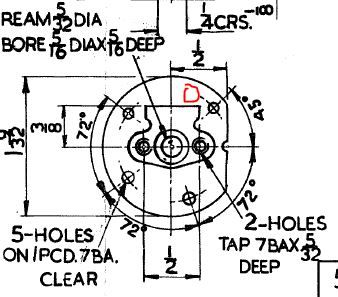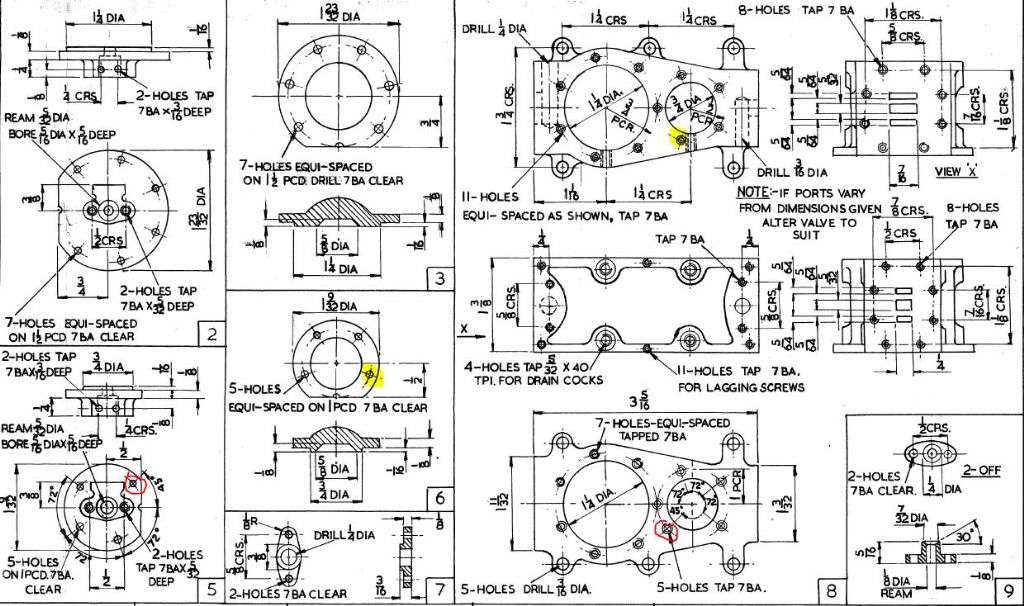Stuart Turner Twin Launch engine
Pcd
| Arthur Goodwin | 21/12/2021 20:49:05 |
| 71 forum posts 45 photos | Hi all Just starting my 3rd stuart engine with a big challenge taking on the twin launch. I got the kit off market place all intact but very old. The drawings are dated 1975 and are yellow with age. Perusing said drawings my attention was drawn to the cylinder block and the pcd for bolting end caps on The top cap says 5 holes eqi spaced but for the bottom cap it gives angles of 72 deg and 45 deg. Any body know why as its still the same 5 hole config. See attached pics |
| Arthur Goodwin | 21/12/2021 20:55:44 |
| 71 forum posts 45 photos | |
| JasonB | 21/12/2021 20:57:50 |
25215 forum posts 3105 photos 1 articles | If it's anything ;like the compound the 45deg position is due to the fact if you used the equal 72deg pattern the hole would place the nut in the way of the cross head guide. The compound shows the 45deg on both the underside of the cylinder casting and also on the cover so the two match Edited By JasonB on 21/12/2021 21:00:39 Edited By JasonB on 21/12/2021 21:02:09 |
| Arthur Goodwin | 21/12/2021 21:18:35 |
| 71 forum posts 45 photos | Hi jason Yes I see that now. It was the drawing for the top cover that puzzled me saying "5 equi spaced holes" when they obviously arn, t Thank you |
| JasonB | 22/12/2021 07:33:38 |
25215 forum posts 3105 photos 1 articles | I'm not sure why your drawing also shows the covers on the top of the cylinder having the uneven spacing as it is only needed on the underside for the reason stated. I only have drawings for the compound and that shows the equi-spaced back (top) covers which would look a lot nicer and should not give a problem with proximity to the drain cock holes First image here has them equi-spaced which looks better than the video image lower down, plenty of clearance to the drain cocks and also a couple of threaded holes added to aid removal of the covers
Edited By JasonB on 22/12/2021 07:38:29 |
| JasonB | 22/12/2021 07:44:57 |
25215 forum posts 3105 photos 1 articles | There is a good build thread on John Bentley's site. He has top equi-spaced and the bottom with the 45deg and you can easily see why it needs to be that way from his photos. |
| Arthur Goodwin | 22/12/2021 10:13:19 |
| 71 forum posts 45 photos | Thanks Jason Been on John Bentley site and it will be my main point of reference from now. Regards
|
| Arthur Goodwin | 24/12/2021 17:07:59 |
| 71 forum posts 45 photos | Hello As previously stated my drawings are from 1975 and do not feature the exploded schematic as included on modern drawings. I use this primarily to locate and identify small parts. As any kind soul got one that they could send me. Thank you in advance and merry Christmas to you all. Arthur |
| Arthur Goodwin | 30/12/2021 21:35:29 |
| 71 forum posts 45 photos | Hi Just completed the 3 main bearings. On John Bentleys site the last thing he does is to bolt them to the sole plate and "Bed Them in " using his lathe as the power source. When he says bed them in, is he referring to lapping ie using paste or is he just relying on the crank to bed them. Regards |
| Ramon Wilson | 30/12/2021 22:44:12 |
1655 forum posts 617 photos | I wouldn't use lapping paste other than to lap the bearing bores independent of the shaft bearing areas to size if required. If a crank isn't turning freely with the bearings fitted up tight albeit possibly on the tight side all lapping paste will do is wear the high spots off the bearing and shaft. 'Bedding in' should not be considered a means to cure misalignment issues Much better to find any discrepancies and deal with any alignment issues first before bedding in. For instance if a bearing is a good running fit on it's shaft position when free but upon being tightened down has a marked tightening effect on the shaft - search for and cure that issue first until satisfied taking each bearing in turn. The shaft may be tight in the bearings but that tightness should be uniform throughout it's rotation - no tight spots in one, or more areas. It should not be so tight as to require force to drive it to 'run it in'. Just about to do this with my marine engine build and will only use paraffin and oil to lubricate as the shaft is brought to a running fit Tug |
| John Olsen | 31/12/2021 06:43:47 |
| 1294 forum posts 108 photos 1 articles | You may already know this, so sorry if I am teaching my grandmother how to suck eggs here, but it is important for the holes in the bedplate and the cylinder block to line up. One way to do this is to make a jig plate which is just a bit of flat stock with the holes drilled in it. You use it twice, once to do the holes in the bedplate and then again to do the holes in the block. If both sets of holes match exactly, the columns will go in without side loads, which makes assembly easier. The other thing that helps is if you can make all the columns themselves exactly the same length between the shoulders that seat against the bedplate and the block. regards John |
| JasonB | 31/12/2021 07:13:42 |
25215 forum posts 3105 photos 1 articles | There are several people who seem to "motor" their engines for an hour or two to get rid of tight spots but that likely leaves a loose area on the opposite side of a bearing. Like Ramon I'm not one to do that. Just work through the parts as you build up the engine getting the "fit" right before making the next. One alternative is to leave the bearings undersize and then finish bore them in position with a between ctrs boring bar but the twin launch size would mean a bit of a spindly boring bar so not ideal on this size engine. As Ramon mentions if the bearings ran free on the shaft before fitting into place but are tight when fitted then the fit is not in line so adjust the bearing positions, If the crank gets tight through one arc of it's rotation but is free for the rest then it is probably not straight. Since fitting a DRO to the mill jigs and templates have become a thing of the past as hole positions are repeatable provided you don't misread the box of tricks. |
Please login to post a reply.
Want the latest issue of Model Engineer or Model Engineers' Workshop? Use our magazine locator links to find your nearest stockist!
Sign up to our newsletter and get a free digital issue.
You can unsubscribe at anytime. View our privacy policy at www.mortons.co.uk/privacy
- *Oct 2023: FORUM MIGRATION TIMELINE*
05/10/2023 07:57:11 - Making ER11 collet chuck
05/10/2023 07:56:24 - What did you do today? 2023
05/10/2023 07:25:01 - Orrery
05/10/2023 06:00:41 - Wera hand-tools
05/10/2023 05:47:07 - New member
05/10/2023 04:40:11 - Problems with external pot on at1 vfd
05/10/2023 00:06:32 - Drain plug
04/10/2023 23:36:17 - digi phase converter for 10 machines.....
04/10/2023 23:13:48 - Winter Storage Of Locomotives
04/10/2023 21:02:11 - More Latest Posts...
- View All Topics
- Reeves** - Rebuilt Royal Scot by Martin Evans
by John Broughton
£300.00 - BRITANNIA 5" GAUGE James Perrier
by Jon Seabright 1
£2,500.00 - Drill Grinder - for restoration
by Nigel Graham 2
£0.00 - WARCO WM18 MILLING MACHINE
by Alex Chudley
£1,200.00 - MYFORD SUPER 7 LATHE
by Alex Chudley
£2,000.00 - More "For Sale" Ads...
- D1-3 backplate
by Michael Horley
Price Not Specified - fixed steady for a Colchester bantam mark1 800
by George Jervis
Price Not Specified - lbsc pansy
by JACK SIDEBOTHAM
Price Not Specified - Pratt Burnerd multifit chuck key.
by Tim Riome
Price Not Specified - BANDSAW BLADE WELDER
by HUGH
Price Not Specified - More "Wanted" Ads...
Do you want to contact the Model Engineer and Model Engineers' Workshop team?
You can contact us by phone, mail or email about the magazines including becoming a contributor, submitting reader's letters or making queries about articles. You can also get in touch about this website, advertising or other general issues.
Click THIS LINK for full contact details.
For subscription issues please see THIS LINK.
Model Engineer Magazine
- Percival Marshall
- M.E. History
- LittleLEC
- M.E. Clock
ME Workshop
- An Adcock
- & Shipley
- Horizontal
- Mill
Subscribe Now
- Great savings
- Delivered to your door
Pre-order your copy!
- Delivered to your doorstep!
- Free UK delivery!














 Register
Register Log-in
Log-in


